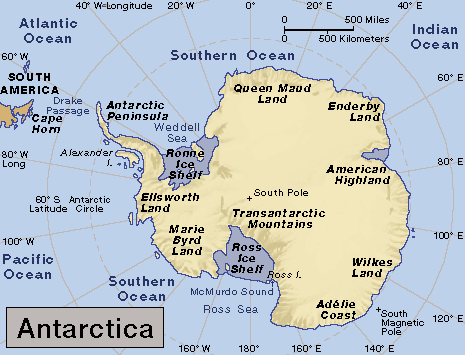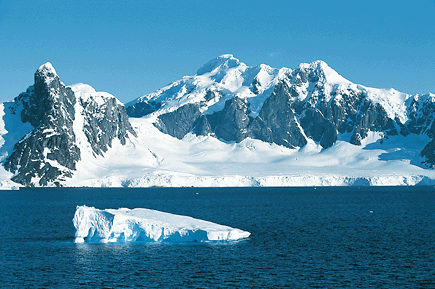“Grand Canyon of Antarctica” Discovered
Friday, July 27th, 2012July , 2012
A huge canyon nearly as deep as the Grand Canyon has been discovered beneath a remote area of the West Antarctic ice sheet, a team of British scientists has reported. Scientists think that the canyon, which lies buried under nearly 1 mile (1.6 kilometers) of ice, may be a major reason for the dramatic loss of ice from West Antarctica over the past 20 years. The previously unknown canyon, named the Ferrigno Rift, lies beneath a massive glacier known as the Ferrigno Ice Stream, located just west of the Antarctic Peninsula. Satellite data collected over several decades has documented both a significant drop in the depth of the ice stream as well as an increase in the amount of ice breaking off into the Southern Ocean, which surrounds Antarctica. Scientists have calculated that melting ice from West Antarctica is responsible for nearly 10 percent of the current rise in global sea levels.

(World Book map; map data © MapQuest.com, Inc.)
The canyon was discovered by scientists from the University of Aberdeen in Scotland, who spent a brutal nine weeks measuring the topography of the ice stream’s rocky base using ice-penetrating radar devices hitched to snowmobiles. Glaciologist Robert Bingham of Aberdeen said that the dropoff in his measurements of the depth of the ice was so startling that he drove over the area two or three times to confirm his data.

Antarctica's rugged coast features jagged mountain peaks and glacier-filled valleys. Ice and snow cover 98 percent of the continent. Antarctica is the world's coldest region. (© Rod Planck, Photo Researchers)
An analysis of the data by Bingham and colleagues from the British Antarctic Survey indicate that the Ferrigno Rift is about 6 miles (9.6 kilometers) wide and at least 62 miles (100 kilometers) long. The Grand Canyon is more than 1 mile deep, 277 miles (446 kilometers) long, and from less than 1 mile to 18 miles (29 kilometers) wide. Unlike the Grand Canyon, the Ferrigno Rift was created when sections of Earth’s crust in what is now West Antarctica separated, creating a valley. Erosion likely deepened the valley, which probably formed tens of millions of years ago when Antarctica was ice free. The Grand Canyon was created chiefly through erosion by the Colorado River.
Bingham reported that the rift may be speeding the movement of the Ferrigno Ice Stream to the sea in several ways. Glaciers move more quickly over sediments like those found near the bottom of the rift. In addition, water from the Southern Ocean, which appears to be warming faster than any other ocean, may be flowing into the rift, causing erosion of the glacier from below.
Additional World Book articles:
- Global warming
- Ice formation
- Icecap
- Science in Antarctica (a Special Report)
- The Great Meltdown (a Special Report)


